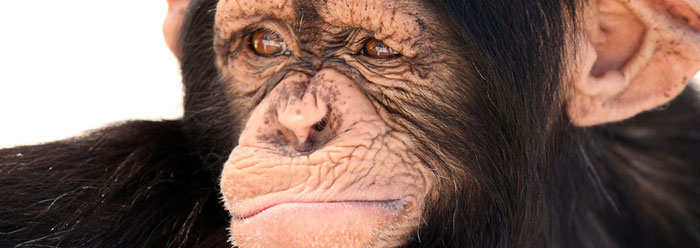Evolutionary science repeatedly declares that chimps and humans are 98 percent genetically identical, which is then taken as solid evidence that mankind evolved from an apelike ancestor. But a former BBC producer’s new book has found reasons to emphasize research that is often overlooked by evolutionary advocates—scientific results that reveal the uniqueness of man.
In Not a Chimp: The hunt to find the genes that make us human, which was reviewed in New Scientist magazine, evolutionist Jeremy Taylor investigated not only the genetic distinctions between humans and apes, but also the behavioral, neurological, and other scientific findings that together led him to conclude that a view that “chimps are practically human” based on their “98.4%” genetic similarity is “nonsense.”1
Chimpanzees may have most of their genes in common with humans, but so do mice. And for that matter, so do kangaroos, according to Jenny Graves, Director of the Center of Excellence for Kangaroo Genomics. She told Reuters that kangaroos and man share mostly “the same genes and a lot of them are in the same order.”2
Yet nobody repeats any percentage similarity in genes between humans and kangaroos because the evolutionary origins myth does not portray humans evolving from kangaroos.
Within genetics research alone, Taylor found that as more and more knowledge gaps are filled in, the “chasm between human and chimp…seems to deepen by the year.”1 He therefore provided independent confirmation of what Dr. Jeff Tomkins of the Institute for Creation Research published earlier this year: The oft-repeated “98.4%” similarity figure was generated by selecting genic DNA―sequences that were already known to be quite similar between the two species―and ignoring the non-genic sequences.3
The researchers did this because at the time, only the genic sequences were thought to carry relevant information. Since then, the non-genic (called “intervening” by Tomkins in his article) sequences have been found to carry essential regulatory information, called “meta-information.” Therefore, both Tomkins and Taylor would seem to agree that more accurate future sequence similarity estimates should take into account this regulatory DNA. And when that is done, the heralded 98 percent figure will be significantly smaller.
The New Scientist review concluded, “Not a Chimp should be mandatory reading for journalists who often reinforce the general public's misconception that chimps are practically human.”1 The ongoing genetic, behavioral, and neurological discoveries summarized in this book highlight the observation that chimps are not practically human. And this fits squarely with the biblical account that mankind was uniquely made in the image of God.4
References
- Callaway, E. 2009. Review: Not a Chimp by Jeremy Taylor. New Scientist. 2721: 44.
- Taylor, R. Kangaroo genes close to Humans. Reuters, November 18, 2008.
- Tomkins, J. 2009. Human-Chimp Similarities: Common Ancestry or Flawed Research? Acts & Facts. 38 (6): 12.
- See also Thomas, B. Chimp Study Reveals Humans Are Uniquely Wired. ICR News. Posted on icr.org April 16, 2009, accessed September 11, 2009.
* Mr. Thomas is Science Writer at the Institute for Creation Research.
Article posted on September 17, 2009.














